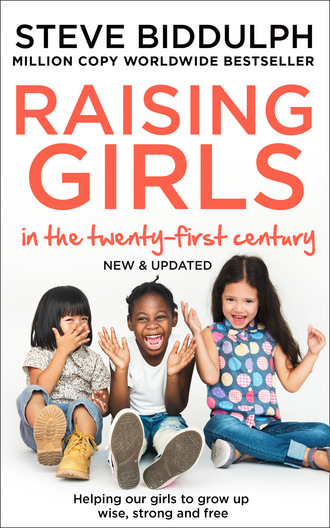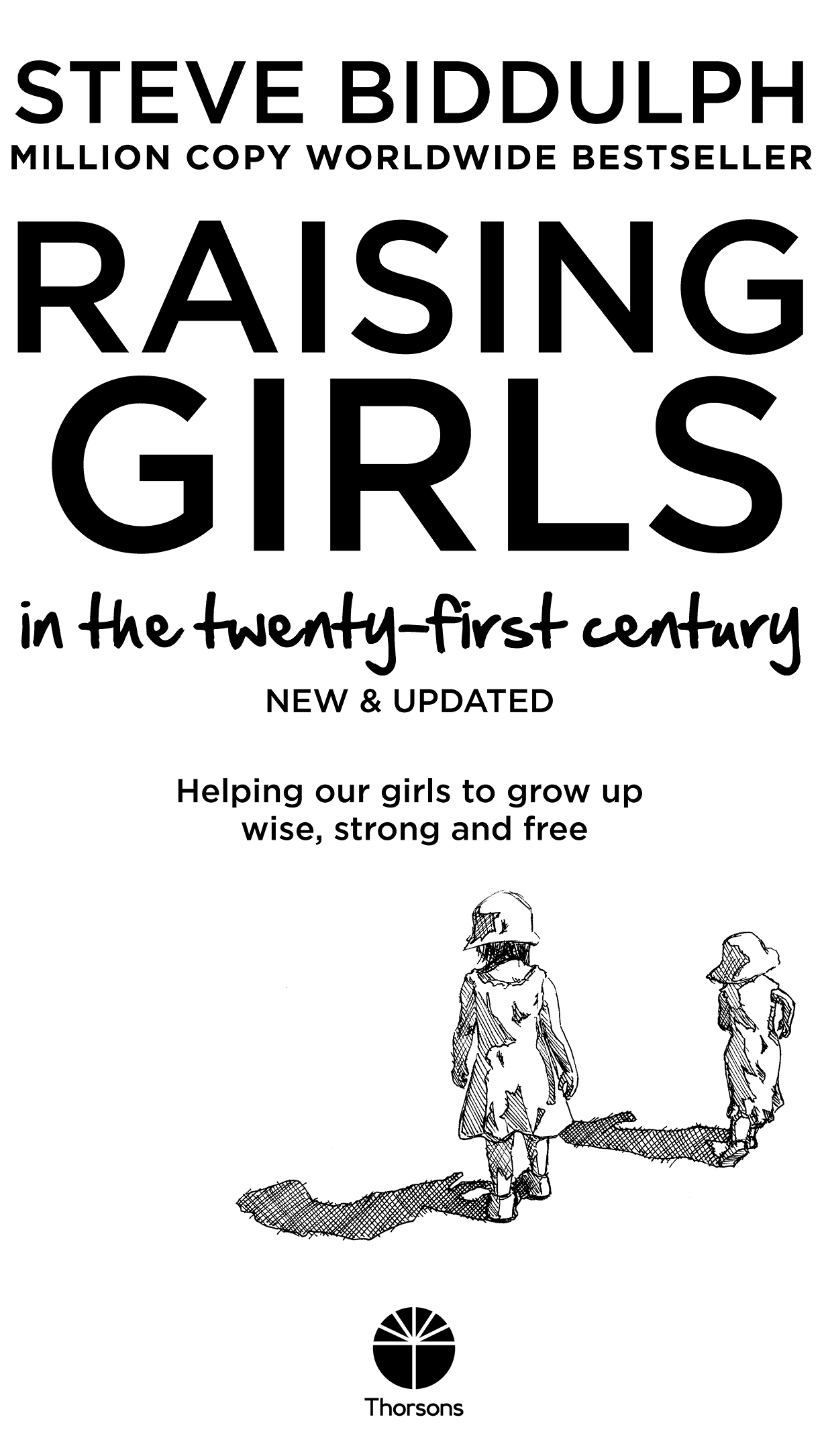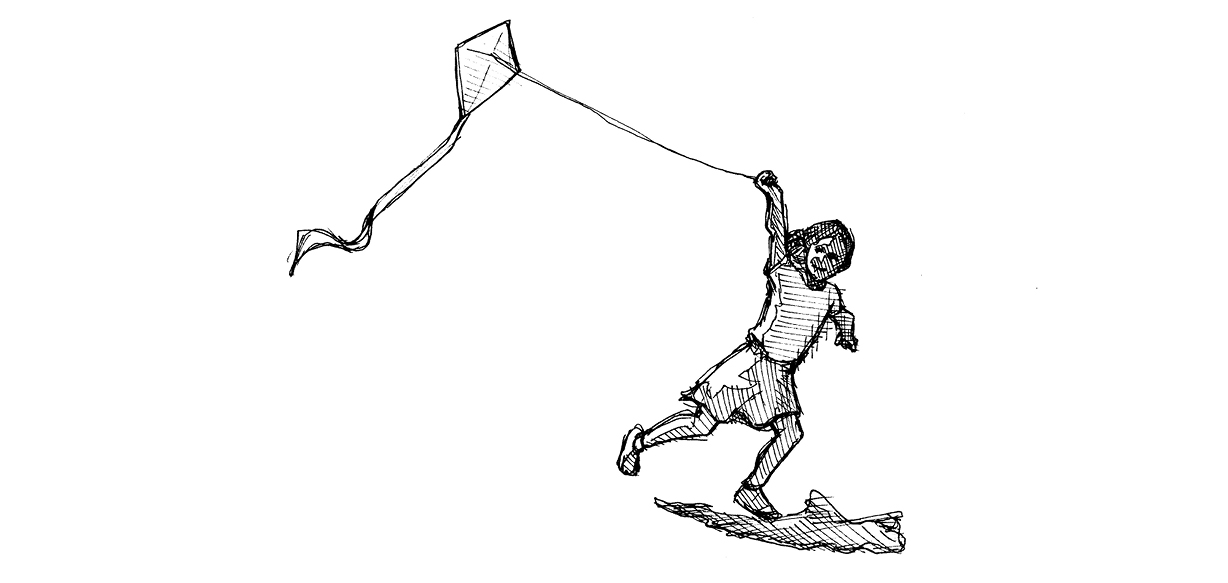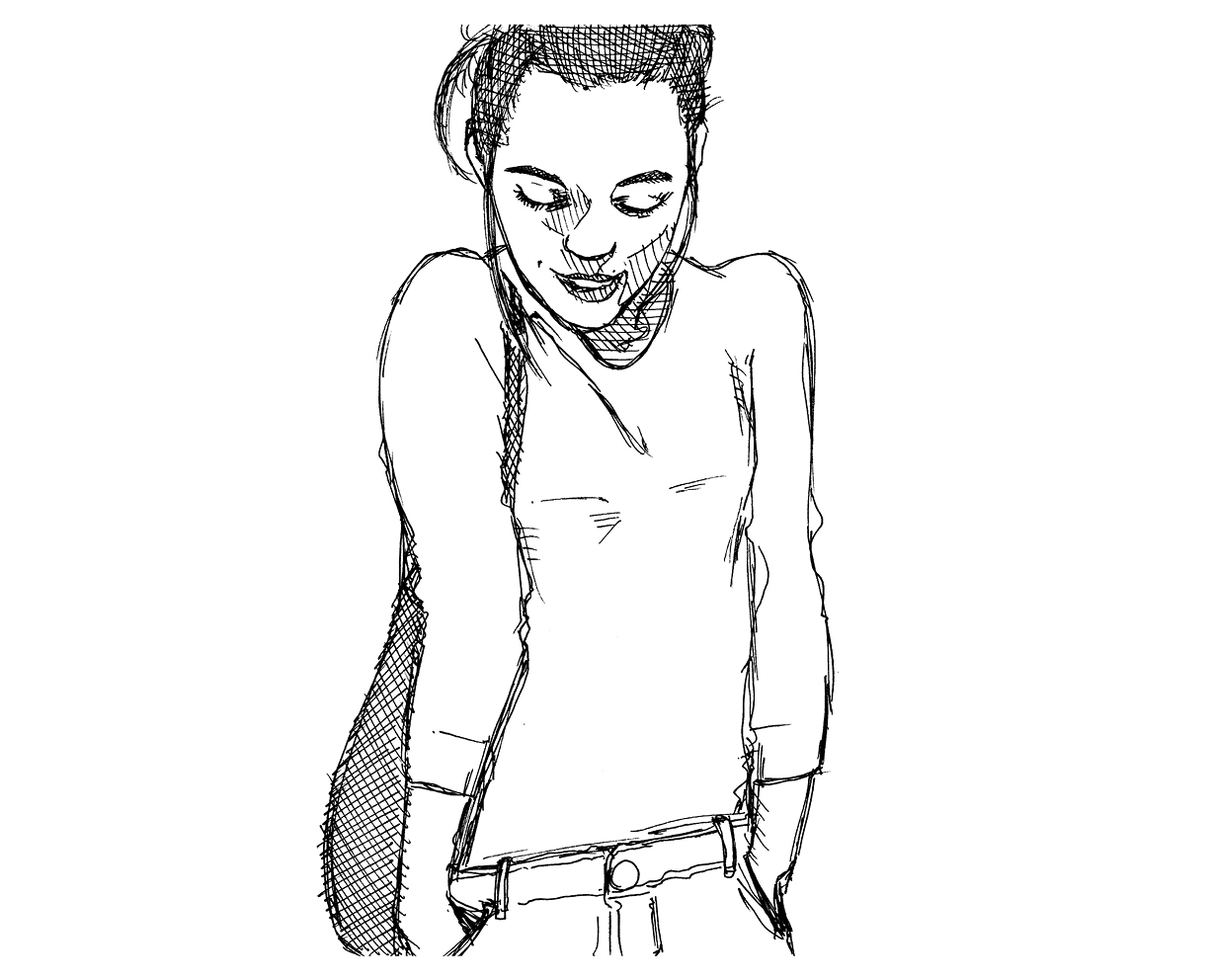
Полная версия
Raising Girls in the 21st Century


Copyright
All content in this book is for the purposes of discussion and awareness only. No advice should be taken without making your own judgement, or in the case of serious problems, seeking professional advice.
Thorsons
An imprint of HarperCollinsPublishers
1 London Bridge Street
London SE1 9GF
www.harpercollins.co.uk
First published by Thorsons 2013
This edition published 2019
© Steve Biddulph 2013, 2019
Cover layout design © HarperCollinsPublishers Ltd 2019
Cover photograph © Shutterstock.com
Illustrations by Kimio Kubo
All photos courtesy of the author unless otherwise stated
Extract in Chapter 7 from Kim McCabe’s From Daughter to Woman, Robinson 2018. Used by permission.
Section on self-harm in Chapter 10 adapted with permission from the Lifeline Australia website: www.lifeline.org.au/get-help/topics/self-harm
A catalogue record of this book is available from the British Library
Steve Biddulph asserts the moral right to be identified as the author of this work
All rights reserved under International and Pan-American Copyright Conventions. By payment of the required fees, you have been granted the nonexclusive, non-transferable right to access and read the text of this e-book on screen. No part of this text may be reproduced, transmitted, downloaded, decompiled, reverse engineered, or stored in or introduced into any information storage retrieval system, in any form or by any means, whether electronic or mechanical, now known or hereinafter invented, without the express written permission of HarperCollins e-books.
Find out about HarperCollins and the environment at
www.harpercollins.co.uk/green
Source ISBN: 9780008339784
Ebook Edition: May 2019 ISBN: 9780007455676
Version: 2019-04-02

Contents
1 Cover
2 Title Page
3 Copyright
4 Contents
5 A Flight Manual for Your Girl
6 Meet Kaycee and Genevieve
7 Part One: The Five Stages of Girlhood
8 1 Creating a Total Girl
9 2 Right from the Start
10 3 Learning to Explore
11 4 Getting Along with Others
12 5 Finding Her Soul
13 6 Preparing for Adulthood
14 Part Two: Hazards and Helps: The Six Big Risk Areas and How to Navigate Them
15 7 The Rush We’re All In
16 8 Too Sexy Too Soon
17 9 Mean Girls
18 10 Bodies, Weight and Food
19 11 Alcohol and Other Drugs
20 12 Mirror, Mirror on the Screen
21 Part Three: Girls and Their Parents
22 13 Girls and Their Mums
23 14 Girls and Their Dads
24 What Happened to Kaycee?
25 Special Bonus Section: Where Do I Go from Here?
26 Notes
27 Contributors and Acknowledgements
28 Also by Steve Biddulph
29 About the Publisher
LandmarksCoverFrontmatterStart of ContentBackmatter
List of Pagesiiiiv1235678910111213151617181920212223242527282930313233343536373839404142434445464748495051525354555657585960616263646566676869707172737475767778798081828384858687888990919293949596979899100101102103104105106107108109110111112113114115116117118119120121122123124125126127128129130131132133134135137138139140141142143145146147148149150151152153154155156157158159160161162163164165166167168169171172173174175176177178179180181182183184185186187188189190191192193194195196197198199201202203204205206207208209210211212213214215217218219220221222223224225226227228229230231232233234235236237238239241242243245246247248249250251252253254255256257258259260261262263264265266ii
A Flight Manual for Your Girl
Will she fly or will she crash? It’s up to you!
What’s it like being a girl today? Well, as you must have noticed, it’s not like when we were kids. It’s different in good ways and bad. On the plus side, many girls are soaring. A huge battle has been won for the rights of girls; they can aim for a life which even their mothers couldn’t have, let alone their grandmothers or the women of centuries before. Today around three out of every five girls will turn out just fine.1 They will power along through their growing-up years, with just the odd minor challenge that we all need to help us grow, and head off into a happy adulthood. If you are reading this book, then you are the kind of parent who is motivated and open to ideas – and your daughter will likely have a great start.
But your daughter will have friends whose lives will not go at all well. One girl in five, during her teenage years, will encounter problems, usually with her mental health or – somewhat less often – with behavioural issues such as substance abuse, lawbreaking or risky sexual behaviour which will put her in jeopardy. And because the mid-teens are the peak time for hormonal activity and neurological meltdown, this age is when it will probably show up. If a girl is going to go off the rails, you will know it by fourteen.
Fortunately for this one-in-five girl, her family will mobilise. They will get help and make changes. Caring teachers, the family doctor or a counsellor might help. And that girl will ‘come good’. She will pull out of the dive she is in and become stronger and more secure. Kaycee, who features early in this book and is the heroine of my Raising Girls talks, is a real-life instance of this. Everyone in her family made changes and her life was turned around.
So that’s four out of five girls who are going to be okay. But if you’re keeping count, that leaves one more. One in five, still a huge number of girls, don’t do well. They have problems starting in their teens, and those problems don’t go away. They will have impaired lives right into their twenties and beyond. Mental health professionals have been on full alarm mode for several years now because this is an awful lot of girls having a really terrible time. This is new, and it’s a big problem. Something has gone wrong.
We’ve all seen this happen to girls we know. Once-rare conditions like eating disorders, or self-harm or out-of-control anxiety are now present in every classroom in the western world. Schools have teams of psychologists now. They build ‘wellbeing centres’ and have wellness programmes, but it’s a euphemism for ‘don’t commit suicide’. In some schools I have visited, if a girl disappears during the day a counsellor is sent, quickly, to the railway station to check she isn’t standing on the platform in a state of acute distress. These are precious kids and it’s terrible to see the pain and danger they are in.
But why is this? For years I struggled to try to get across to parents what the girls I was talking to were experiencing. But here’s my best attempt – it’s like being out in an open wasteland, alone and exposed. There’s a cold wind blowing. It’s getting dark, and predators are circling. Girlhood has never felt more lonely.
Even though they have loving and devoted families, many girls today feel emotionally abandoned because their parents and teachers simply no longer have enough time or peace to really connect with them. So they are left to the wolves of the peer group, the internet, and a corporate machine that wants them insecure so they will buy more stuff. We adults have not provided what they need – in fact home and school combined have often piled on pressures and expectations that makes things worse.
From 40 years of working with families I have become convinced that a big part of the problem is the way we live. We have, little by little, slipped into an overbusy, overloaded and overwhelmed life, with some crazy values and ways of spending our time. Our daughters need something more, which we are no longer providing – rich and varied adult connection, mentoring and chances to contribute. Instead, they have taken to the online world for affirmation and comfort, but it isn’t a good or caring place. Instead of finding encouragement that they belong, they are blitzed with media and have become much more pressured to achieve in every way, look good, be amazing and be perfect. The rushed way of life of today is not what humans were designed for. We feel it as adults, but our children – from the littlest toddler girl to the most sophisticated looking (but inside oh-so-fragile) teenager – are being hammered.
We have to change how we live in order to save our girls. We need more heart and time if we are to help our youngsters grow strong. It begins when they are little babies, and continues until when they are fully adult. It’s made up of small things you do every day, which this book will help you to put into action.
Once you put some fences around your life and embrace happier, slower rhythms, then girlhood will be much more natural, smooth and happy. She will love and laugh through her growing-up years, and even the teens will be more adventure than angst. We will teach you all about these stages and how to make them happy and rich in the pages that follow. But the real magic is built into your girl. You just have to release it.
As we free our girls from the monster machine that life has become, we set ourselves free too. Kids change us, and for the better. So your daughter – and her friends – can learn to fly.
Good wishes and my love goes with you,
Steve Biddulph
Meet Kaycee and Genevieve
There are two girls that I would like you to meet. Their names are Kaycee and Genevieve. Both are 17, and both are in Year 12 at school. They are great kids, friendly and bright, you would enjoy talking to them.
These two have known each other since nursery. They were best friends all through primary school and everyone thought they would be that way forever. But around the time Kaycee and Genevieve moved up to secondary school, something went wrong between them. The reason is hard to say, I am not sure they could even pin it down themselves, but today, if they pass in the school corridor, there is that awkward feeling that comes from having once been friends, but no longer being so.
Kaycee and Genevieve’s lives have taken very different paths. I’m going to tell you their stories, because they make really clear the dangers, and the hopes, of girlhood today.
Kaycee’s Story
Let’s meet Kaycee first. On first impression Kaycee seems a very grown-up 17-year-old. She wears carefully applied make-up and ultra-fashionable clothes, and she speaks fast and in a clear voice. This much confidence in a teenager may be quite genuine, but if you know young people well, you might wonder if Kaycee has possibly become ‘too old too soon’. And there is something else that you might notice. It’s in her manner. Her expression is world-weary. When she speaks she sounds rather cynical and hard. For a 17-year-old, she doesn’t seem to be having a lot of fun.
Back when Kaycee was 14, something big did happen. It wasn’t the stuff of newspaper headlines, but it was a significant experience that affected the direction of her life.

Halfway through Year 9, Kaycee was invited to a classmate’s birthday party. The parents hosting the party had implied a somewhat higher level of supervision than they actually provided on the night. So the party went pretty much as it would if 40 or 50 kids of varying ages were left in a house at night with lots of alcohol and no adults in sight: loud, chaotic and out of control. Kaycee found it very exciting; in particular because a boy whom she knew, Ciaran, aged 17 and two years above her in school, was there. Kaycee and her friends had often admired Ciaran at school, with his good looks and cool demeanour, but tonight there was something different – he was noticing her. Then, amazingly, it got better still. He sat with her, and they talked and had a few drinks. They talked and snuggled a little in the garden. She could hardly believe her luck (it was all she could manage not to take out her phone and text someone!). After a while, Ciaran stood up, took her by the hand and led her upstairs to one of the many bedrooms in this big, fancy house apparently devoid of adults. They had sex.
It all went faster than Kaycee had imagined her first sexual experience would, and it was less tender too. Blurred by the alcohol, Kaycee’s brain wasn’t really working very well; she was aware though of the shift from the excited feeling of being special and the centre of Ciaran’s attention, to physical discomfort and a sense of being pushed about, invaded, not really noticed as a person. When it was over, which was quite soon, Ciaran managed a kiss before straightening his clothes and leaving the room. When Kaycee got herself together and went out into the party, she felt unsure and shaky. Then she saw Ciaran, standing with a group of friends, who all looked at her and smirked. She realised in an instant that he had been telling them of his ‘conquest’. Tears burned her face, she fled from the house and ended up in the garden, sobbing. A friend tried to comfort her, but Kaycee wouldn’t say what had happened.
She went home that night in a kind of icy rage. She hated Ciaran now, and for a while boys in general. Kaycee was a spirited girl, she had been independent all her life, her busy parents valued self-sufficiency. She told no one what had happened. (When her parents finally learned about it three years later in a family counselling session, they were saddened and shocked.) But like millions of girls before her who had first sexual experiences they regretted or did not enjoy, Kaycee hid her wounds and got on with her life. But she was a changed girl.
Did the experience put her off boys? Not at all. What it put her off was vulnerability, being the one who was used. She began sleeping with boys on her own initiative, and on her own terms. She chose them, and she called the shots. By the age of 17, when she first spoke to a counsellor, Kaycee had had sex with seven different boys. Possibly eight, there was a night where some alcohol-affected confusion had occurred, and she wasn’t sure.
Now, in Year 12, Kaycee has stabilised somewhat, she has a steady boyfriend. But she doesn’t hold him in very high regard, and confides that she is ‘planning to ditch him sometime soon’.
We know from research, (and from most people’s recollections of their own teenage years), that Kaycee’s experience is not uncommon. Perhaps, one could argue, we just need to be less uptight about teen sex and let them make their own mistakes, and learn from them. (That is also a convenient argument for those parents who prefer not to get involved, or are too busy to keep a close eye on their kids.) But let’s stay with the story …
Kaycee’s life, at this point in time, isn’t going very well. Her parents sought help not because of her sex life, which they were only vaguely aware of, and in a sense didn’t want to know about. Their concern was that her drinking was getting out of control (she was not yet, of course, of drinking age) and she was failing at her expensive private school. She was halfway through Year 12 and the school was concerned about her poor marks and her many absences from class. The family had been advised to ‘see someone’ about her problems. When she arrived with her parents to meet with a counsellor, Kaycee looked angry to have been brought there. But within half an hour, and given a sympathetic listener, she was pouring out her feelings.
The family’s seeking help – not just for Kaycee, but for themselves – was a brave step, and in fact proved to be a turning point. We will return to Kaycee and her parents at the very end of the book, to let you know how it all worked out.
A Marked and Sudden Change
In the last ten years there has been a big change in the lives of girls. And it’s affecting them at every age, from babyhood to teens. While the same wishes and dreams are there for girls journeying towards womanhood that we had in our day, the world is forcing changes on them that are on a whole different scale. In particular, things are beginning to happen when they are younger.
This is a key point to keep in mind about girls’ situation today, and it was first made by Maggie Hamilton in her book What’s Happening to Our Girls? To understand our daughters, we have to realise that their childhood is not like ours. To put it bluntly, our 18 is their 14. Our 14 is their ten. That’s in terms of the pressures, the behaviours, and what they are supposed to be, and act like, according to the peer norms that exist today – and our failure to protect them, for we are partly responsible. We – and that’s all of us, parents, relatives, friends and society – are not supporting girlhood in the way we once did. We haven’t put enough adult time and care around our daughters, or taught them well enough.
In the last ten years a greedy corporate world has realised that girls, and especially pre-teen girls, are a soft target. Companies saw that there were enormous profits to be made in exploiting their anxieties (or in fact creating those anxieties) about everything from skin to weight to friendship to clothes to even making it into adulthood. In boardrooms and advertising agencies, magazines and media outlets, the war on girls began. And it succeeded. Everywhere she looks, today’s young girl sees messages that make her feel she is not good enough, that imprison her in cramped and narrow ideas of how she is supposed to look, think and act. Never before has girlhood been under such a sustained assault, ranging through everything from diet ads, alcohol marketing, fashion pressures, to the inroads of hard pornography into teenage bedrooms.
The result is that many girls have lost four years of childhood peace and development. They are being forced out of childhood when they have not yet completed it, or even fully enjoyed it. The result is girls in enormous pain and confusion. They try to act grown-up but they can’t. They are filling up the mental health clinics, the police stations and emergency rooms, the alcohol and drug treatment programmes in numbers never seen before.1
If we are awake to what is going on, we can prevent this. Partly it’s through the love we give, partly the environment we create for them with support and interests, and partly the protection from the stupid and exploitive media messages from the world around them. I have a favourite saying that has often helped me: ‘We can’t stop the birds of sorrow from flying through our lives, but we don’t have to let them make nests in our hair!’ We can live in this world, but we don’t have to swallow everything it offers us. We can choose for ourselves and for our daughters the experiences that make us strong, happy and alive. That’s what Genevieve and her parents did …
Genevieve’s Story
Genevieve, like Kaycee, is also 17, also in Year 12. On first meeting, Genevieve seems a little nervous and shy, but she soon relaxes when she gets to know you. Her conversation is full of ideas, concerns and funny stories and perspectives on things. She switches in a moment from excited child to thoughtful young adult, as is typical of someone just on the edge of womanhood. She doesn’t have the tough exterior of Kaycee, but then, perhaps she doesn’t need to. Her story is a very different one.
Genevieve does not have a boyfriend right now. She would love to, but is wary; she knows that young love is not always easy. Also, she finds the boys of her own age frustratingly hard to hold a conversation with, and longs to meet more mature, communicative boys when she goes to university.
Genevieve’s friends at school are a warm and friendly bunch, not the high flyers, but the quieter, more natural kids. They look out for each other and also, if there is a newcomer or someone left on the outer edges of the group, they are more likely to include them and make them welcome. As a result, they are a large, ramshackle group, slightly dorky and uncool but not too worried about it.
Genevieve did go out with a boy at 15, and this was an intense experience for her. Justin was her own age and they met early in the school year. They spent time together as often as they could, taking long walks, holding hands, having soulful conversations. He was more experienced sexually, though, and after a few months, began pressuring Genevieve to ‘go further’ when they were alone together. Other girls had had sex with him in the past and he really wanted this with Genevieve too.

Genevieve is close to her mother, and accustomed to talking over pretty much everything in her life with her. In fact, her mother joked that for every hour spent with Justin, Genevieve spent another hour discussing what had taken place, what he said, what it might mean, what she said back, and so on! While many girls do this detailed debriefing with their friends, Genevieve was used to discussing her innermost thoughts with her mum, and so this new problem naturally became part of their ongoing conversation. As a result, her mum was involved in dealing with this new sexual pressure on her daughter, and able to offer her help.
To her great credit, Genevieve’s mum did not panic, and did not try to take control of the situation by telling Genevieve what to do. She later told me that she would, if necessary, have brought in some limits on how and where the pair could meet, since they were below the legal age, as well as the wise age, to start having sex. In other words, she would not allow her daughter, at just 15, to be out of her depth in a situation where she might not be emotionally and physically safe. At the same time, Genevieve’s mum supported, cautiously, her wish to have a friendship with a boy. She would drive her daughter into town to meet Justin to go to a movie or meet up with friends, or bring him over to visit their house.
This remarkably sensible mother had a low-key but thoughtful response to her daughter’s questions. Instead of ‘laying down the law’ as a first strategy, she simply helped Genevieve to explore her own wants. What did she feel she wanted? What was her body telling her? What did she think was the course of action she would feel good about, long term?
She did this in a quiet, casual kind of way that gave Genevieve real space to reflect. Her mum had that knack of listening intently without pressure, so that Genevieve knew that she had her full attention, and so her thoughts and feelings tumbled out effortlessly.
Genevieve’s inner signals were quite clear. She really liked Justin, she liked being with him, but she felt uneasy and rather crowded when he was too physical with her. It was all a bit too intense. She hoped their relationship would strengthen and grow, but she wanted it to take its time. Her mother listened, and nodded, and reflected back to her daughter, ‘It sounds like you really aren’t ready to have sex with him, you don’t want it to go that way right away?’ Genevieve said no, but she was worried what would happen if she rejected Justin’s advances repeatedly. They talked over how she could let Justin know her feelings and wants.



